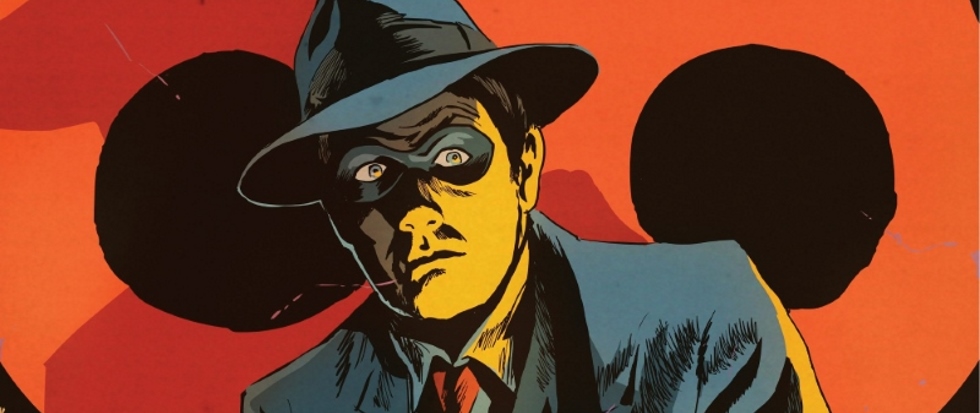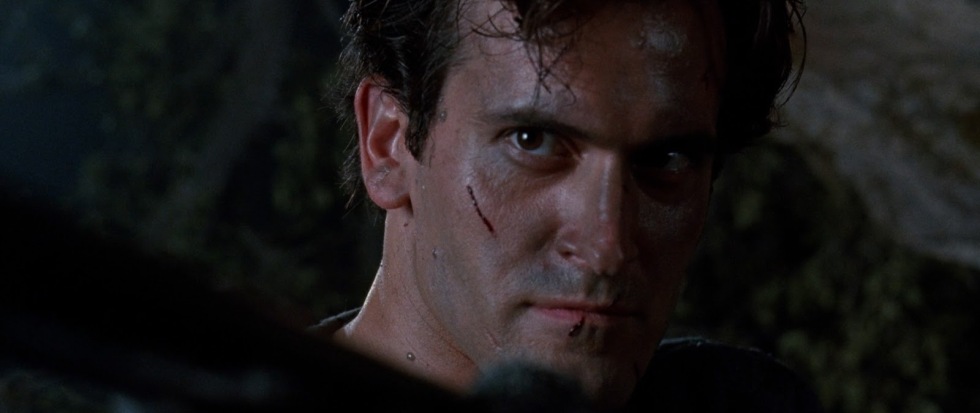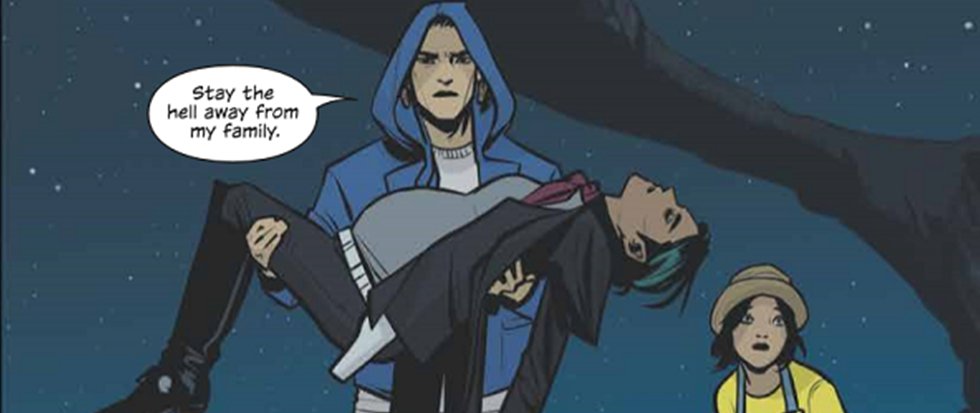Last Week’s Comics 3/21/2012
Avengers Assemble #1
(Marvel – writer: Brian Michael Bendis; art: Mark Bagley)
I get why Marvel is pushing for an Avengers comic. With the movie a mere month and half away, it’s a good idea to remind audiences of why the Avengers are such an iconic grouping of heroes. But Avengers Assemble is a mixture of random moments involving the Avengers, and doesn’t do much to give the team the shot in the arm it needs to make this comic worth reading.
 The story bounces from a group of villains calling themselves “The Zodiac” to the opening of the new Avengers Tower without any connecting phrase in between. This happens again a page later, and then we’re taken to the desert where, for some reason, the Hulk is sitting, deep in “thought,” on a rocky hillside. A convoy appears and then it’s attacked by some type of water elemental.
The story bounces from a group of villains calling themselves “The Zodiac” to the opening of the new Avengers Tower without any connecting phrase in between. This happens again a page later, and then we’re taken to the desert where, for some reason, the Hulk is sitting, deep in “thought,” on a rocky hillside. A convoy appears and then it’s attacked by some type of water elemental.
This kind of disjointed writing occurs throughout the book. It’s like Bendis took a page from Michael Bay and jammed a series of action sequences together with a thin plot involving secret organizations and super powers. No scene feels connected to the other. Bendis is usually much better than this, so the comic is an ultimate disappointment. When I got to the final page, I thought I was missing part of the comic because the end is so abrupt. Most comics finish with some sort of cliffhanger. This ends right in the middle of the action.
Additionally, the characterization of the Avengers feels out of place. The normally stoic Steve Rogers makes speeches to a large crowd gathered outside the tower, but he sounds like the president of a high school student council. Afterwards, he chides his teammates for letting him drone, but he wears an “aw, shucks” smile the entire time. Tony Stark is not his normal self either. He lacks all the egoism we’ve come to expect of him, and instead he acts like a beaten child. And the Hulk talks like a caveman. And Black Widow acts like the mother of the group.
I could go on and on, but the point is made. This is a weak effort and a poor introduction to the Avengers, especially if Marvel was banking on this comic being a way to lure in new readership. The cover being a rip-off of Jim Lee’s Justice League #1 doesn’t help either.
An overall disappointment, Avengers Assemble is not the comic Marvel needs to push its most anticipated movie.
———
Saucer Country #1
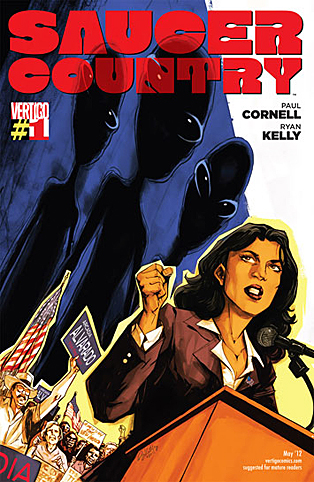 (Vertigo – writer: Paul Cornell; art: Ryan Kelly)
(Vertigo – writer: Paul Cornell; art: Ryan Kelly)
I feel like good UFO stories are hard to find. While some writers tend to go the horror route, other tend to go the comedic route (like Xenoholics and Paul). But where’s the middle ground? Where’s the story that relies less on the aliens and more on the characters? Where’s the story that uses the aliens as a vehicle to get a major point across? It’s here. Saucer Country is definitely an ambitious story with a long-term plan. There are so many different elements at play that Paul Cornell has put himself into a perfect spot to make this debut issue a continuously engaging read.
Saucer County has in its leading lady the perfect main character. An American of Mexican descent, Arcadia Alvarado is the governor of New Mexico. Her current situation makes her a very bankable candidate for the presidency, but she has a secret to deal with.
She’s convinced that she was abducted by aliens and that the world is currently being invaded by them.
Since the majority of the issue is spent on building up her credibility (to the reader, of course), the immediate frustration which she will face is palpable. I feel for Arcadia because I know she’s telling the truth, and I can only imaging the frustration she will feel when she tries to convince people of her predicament. Throw in her bid for the White House, and you have a wonderful mix of conflicts in play. And since the story is going to take us through her presidential run, I see this issue being one which leads to many uncomfortable moments as well as her inevitable breakdown.
Ryan Kelly does a fine job with the illustrations, as much of his work is centered on getting across the strength of the title character. He draws Arcadia in a way that shows she exudes confidence. She’s not a meek leading lady, and her facial expressions and body language convey her power.
What’s interesting is that the majority of men in the comic are subservient. Arcadia’s ex-husband Michael is a broken man; he’s even introduced with a bloody nose. The quirky Harvard professor, Joshua Kidd, also comes across as a weakling. He seems to be schizophrenic and this does little to make him more than an uncomfortably strange person. Even Arcadia’s assistant, Harry, is depicted as an acquiescent old man. The only other female character in the comic is Chloe Saunders, the Republican strategist hired as Arcadia’s campaign manager. Her plan is to mold Arcadia into a sympathetic character to whom people will relate, but she’ll do this through subverting Arcadia’s relationship with her ex-husband. It’s an interesting dynamic, and one that adds an additional layer of interest to what is usually a male-dominated medium.
Political statements abound in this comic, most of them dealing with the idea of aliens – both literal and figurative. It’s as if Paul Cornell wanted to explicitly break several molds at once. He succeeds, I think, and makes a comic that is a strong initial outing in its characterization, pacing and art. I like seeing a comic as a vehicle for a bigger issue, and Cornell does a nice job of making a statement without beating readers over the head with it.
Regardless of political preferences, Saucer Country is worth the read, and has much to offer in its storytelling.
———
Saga #1
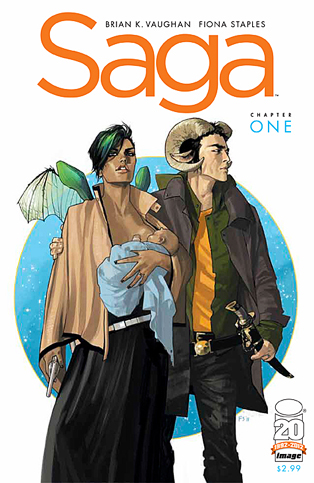 (Image – writer: Brian K. Vaughan; art: Fiona Staples)
(Image – writer: Brian K. Vaughan; art: Fiona Staples)
Bannen’s Book of the Week: I don’t think I can put into words just how brilliant Saga is. After I read it, I had dreams about it that night. To boil this down to a basic statement: If you miss out on Saga, you’re missing out on one of the best comics ever published.
What Brian K. Vaughan and Fiona Staples have done is to create a tangible, eclectic world that is a mix of fantasy, magic, and science fiction. The story is told from the perspective of Hazel, the baby introduced in the early part of the comic, and she’s telling the story from a place of safety. Her recollections are all about past events, so it seems the purpose of the comic is to tell the story of how Hazel was saved.
The comic moves through a landscape inhabited by people with goat horns, wings, and televisions for faces. Think the cantina in Mos Eisley from the original Star Wars, and you’ve got a picture of the assortment of characters that populate the mythical world of Cleave. Vaughan’s dialogue helps solidify the personas of the main characters Marko and Alana. It’s evident they are very much in love, and very happy to have a baby. Their innocence makes them immediately relatable, and much of their banter is tinged with humor. We learn a bit of their backstory, but it’s only hinted at during a separate scene.
What we do know is that Marko and Alana are fugitives, and they’re trying to raise a baby during an intergalactic war. The scale of the conflict isn’t seen yet, but you can grasp its enormity when you glimpse the battle machines and raging fires. By setting the story in space, and making a planet-wide conflict the looming presence it is, Vaughan gives an enormity to the story, and it makes readers even more protective of the main characters because they feel powerless in their situation. And having a newborn doesn’t help.
Fiona Staples does a fantastic job with the tonal qualities of the book. Her illustrations add layers of realism to many fantastical elements. She has a way of mixing painted backgrounds with ink and pencil illustrations so that the characters look vibrant regardless of the setting. Though she doesn’t break from traditional panel construction, Staples’ art never looks repetitive, and not a single page nor a single image feels wasted. The story is brilliantly paced, and it moves seamlessly between its main characters and those people who would derail them from their progress. With a price tag of $2.99, and a hefty 44 pages of story, Saga is more than worth the price of admission.
From its characterization to its illustrations to its story, this comic has exceeded every one of my expectations. It feels grand, like Tolkien’s Lord of the Rings trilogy, yet it still manages to focus intimately on its characters. I’m rooting for Alana and Marko to make it safely to their future. After a single issue, I’m hooked. I can’t wait to see this tale unfold, and I can’t push you enough to get your hands on a copy of this book.


